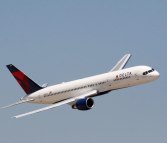Honeywell develops fuel-saving flight management software for airliners
By ANDY PASZTOR
Honeywell International has developed new onboard flight-management software that gives pilots more flexibility to change altitude on long overwater routes, as well as to fly more-precise airport approaches, technology that could save airlines millions of dollars in fuel costs.
One air-traffic control change, which has been approved by the Federal Aviation Administration and is being tested, allows pilots more freedom to climb or descend during trips across the Pacific Ocean based on wind, weather and aircraft weight.
The new procedure is designed to save time and fuel by avoiding headwinds or allowing flight at higher altitudes, where air is thinner and engines burn less fuel.
Some estimates place potential benefits at as much as 3% in savings on reduced fuel use. Others project as much as $200,000 in annual savings per plane while cruising long oceanic routes. United Continental Holdings is running demonstration flights to verify such estimates.
Honeywell’s moves come as other companies pursue different approaches to provide fuel-efficiency benefits on trans-Atlantic flights.
Earlier this year, satellite operator Iridium Communications and NAV Canada, the air-traffic control organization handling the bulk of Atlantic crossings, partnered to provide continuous monitoring of jetliners and supply more complete information about aircraft positions to controllers on the ground.
 The aim is to permit planes to fly closer to each other and encourage controllers to allow adjustments of flight paths to save fuel and avoid storms.
The aim is to permit planes to fly closer to each other and encourage controllers to allow adjustments of flight paths to save fuel and avoid storms.
Airline pilots rely on automated flight-control systems that keep planes on routes with predetermined speeds and altitudes. Changing plans over water can be difficult under the current system because there is no radar coverage and controllers can't pinpoint aircraft locations.
Honeywell's software is designed to make onboard flight-control systems more flexible, allowing pilots to make adjustments as conditions change.
A United Continental spokeswoman said 12 of the airline's Boeing 747 jumbo jets are equipped to use the more-flexible flight paths and 16 test flights have been completed.
Capt. Joe Burns, the carrier's managing director of technology and flight testing, said in a statement the procedures “will allow for more efficient routing and effective management of oceanic airspace while reducing risk.”
A separate software change, which Honeywell is still testing under the auspices of European regulators, allows jetliners to take more-precise paths when they descend toward busy airports.
The change allows pilots to keep engines in idle during such descents, saving fuel and squeezing more planes into busy airways and airports because the planes are more evenly spaced.
The FAA hasn't approved the change yet.
The new fuel-efficient paths are building blocks for planned satellite-based traffic control systems expected to be phased in over the next decade. Regulators and industry officials in the US and Europe are looking for ways to use existing equipment to reduce airline costs years before the broader switch.
Honeywell’s concept makes it easier for pilots to climb or descend during long overwater legs, because cockpit crews have better information about surrounding aircraft. Most big jets on oceanic flights are expected to keep about 50 miles of horizontal separation from jets flying in the same direction.
Honeywell said the FAA and other air-traffic services have agreed to reduce that spacing to as little as 20 miles for certain jets using the new software and procedures.
Honeywell test pilot Markus Johnson, who helped develop the software, said the aim is to keep wide-body jets “from burning extra fuel by being stuck for hours” at lower than optimum altitudes over the Pacific and elsewhere. He said planes going up or down are allowed to pass in front of or behind aircraft cruising at different altitudes.
Also, plans for more-precise airport approaches extend other traffic control techniques widely used at high altitudes.
Commercial and business jets already file flight plans spelling out their anticipated speed and altitude at specific points along their routine cruise path. Now, Honeywell and others working on changes want to add a third variable, precision timing, at lower altitudes.
Honeywell test pilot Joe Duval said the new descent procedures will ensure planes pass designated points within a six-second window, which makes it possible to put more planes into the same airspace and spread out landings more evenly.
The Wall Street Journal (via Dow Jones Newswires)






Comments